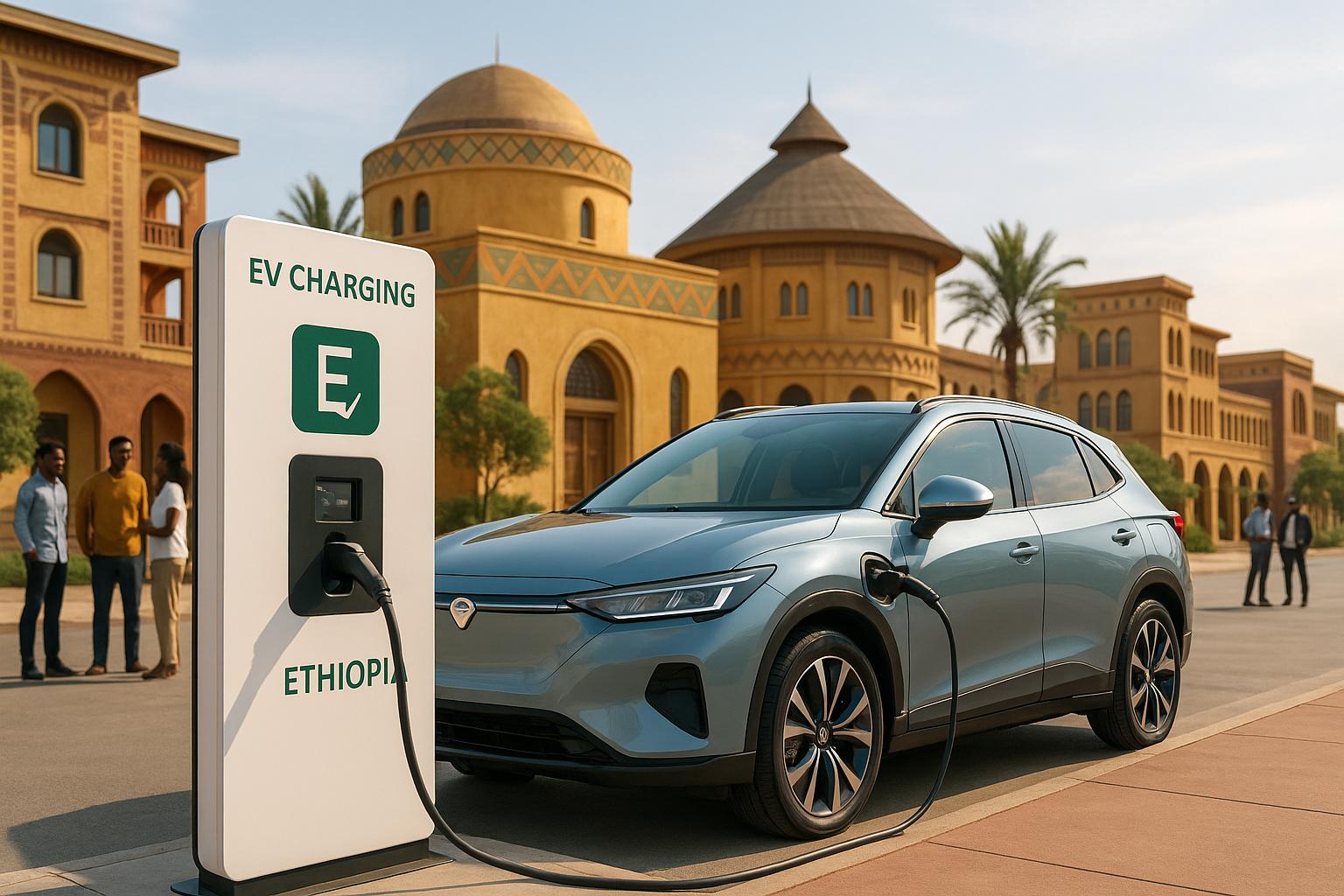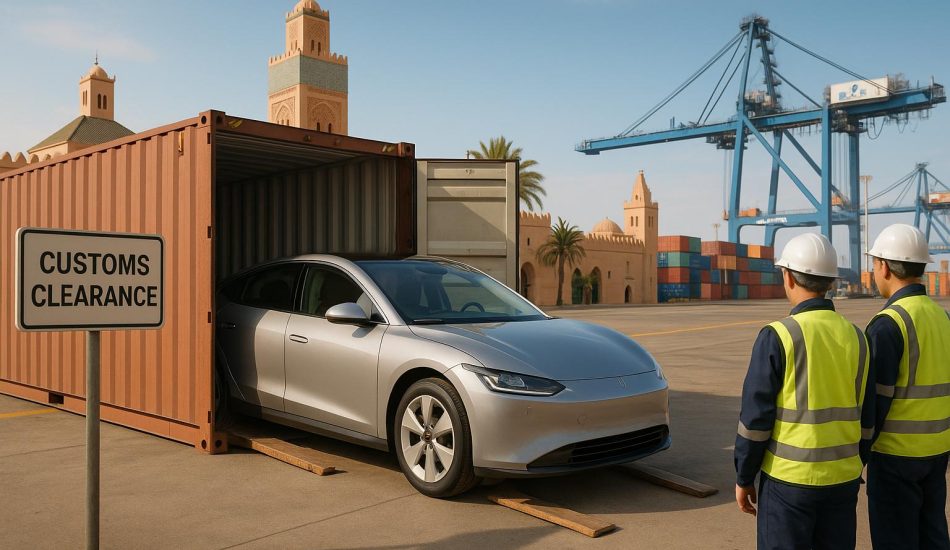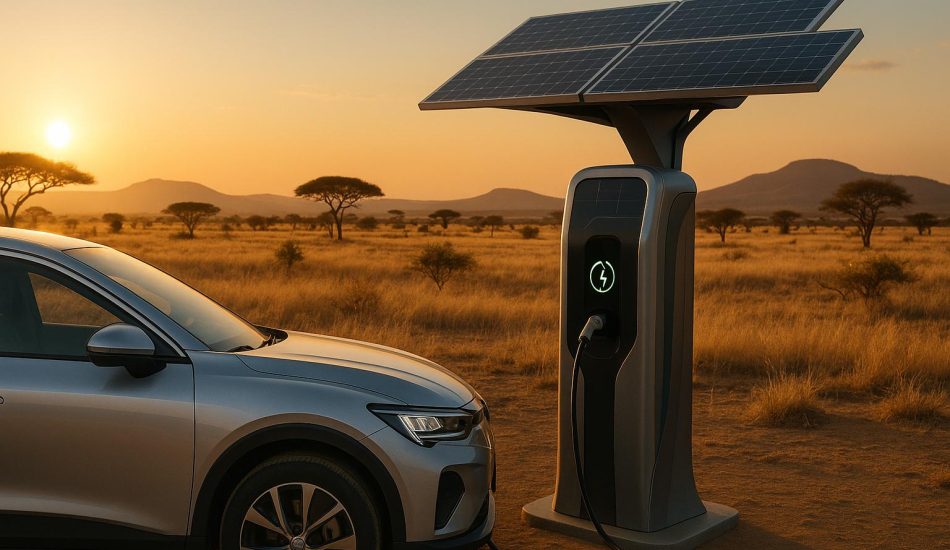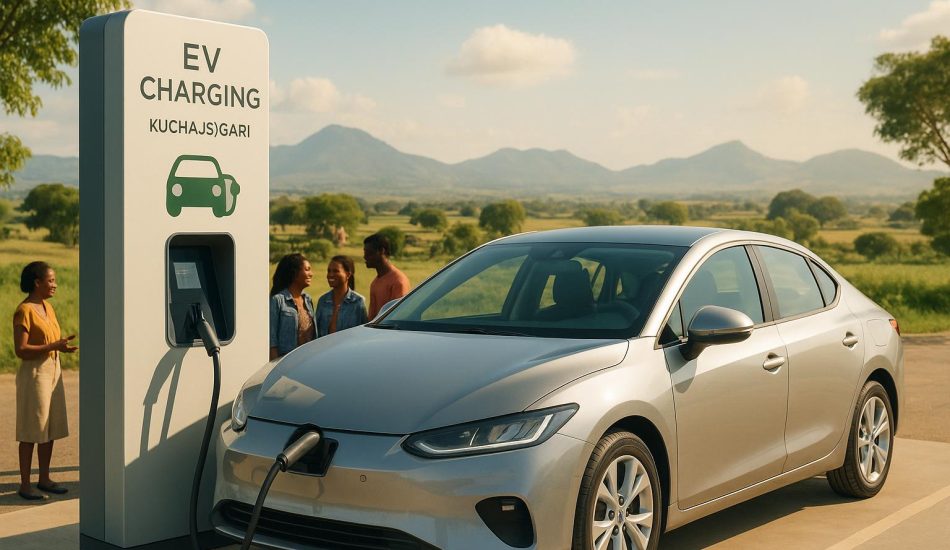
E-Mobility Week 2025 in Ethiopia is set to take place from September 16–18, 2025, in Addis Ababa. This event will unite over 500 participants, including governments, private companies, and development organizations, to address Africa’s electric vehicle (EV) future. Ethiopia, a leader in green transport policies, is hosting the event to showcase its ban on second-hand fossil fuel vehicles, public transport electrification, and hydropower use.
Key highlights include:
- Main Forum: Focused on EV policy, financing, and implementation.
- Special Summits: Youth, Women in E-Mobility, and Policymakers Bootcamp.
- Technology Showcases: New EV models, charging infrastructure, and local manufacturing advancements.
- Regional Collaboration: Partnerships like Charge Africa MOU to align EV strategies across countries.
Ethiopia’s leadership and the event’s focus on investment, policy, industry, and infrastructure aim to accelerate EV adoption and address challenges like unreliable power grids, high costs, and policy gaps. The event also highlights successful projects, such as Senegal’s e-BRT system and Rwanda’s electric motorcycle initiatives, as models for other nations.
Ethiopia Leads Africa’s EV Revolution with Gas-Powered Vehicle Ban
Main Events and Topics at E‑Mobility Week 2025
AEW2025 offers a packed agenda designed to tackle every aspect of Africa’s shift toward electric mobility. This three-day event blends high-level policy discussions with hands-on workshops and summits, creating opportunities for stakeholders to connect and collaborate across the e-mobility landscape. The mix of discussions and practical demonstrations ensures a well-rounded experience for all participants.
At the heart of the event is the Africa E‑Mobility Forum, which serves as the main platform for policy discussions across the continent. This forum will unite decision-makers to address the challenges of electric vehicle (EV) adoption in Africa. Participants will also delve into technical implementations and explore financing strategies in specialized sessions.
AEW2025 goes beyond traditional conferences, offering industry tours that showcase key e-mobility initiatives. The event also includes targeted summits, such as the Youth Summit, Women in E‑Mobility Summit, and the Policymakers Bootcamp, all aimed at addressing specific challenges within the sector.
Key Speakers and Organizations
AEW2025 brings together leading voices from Africa and beyond. CPCS, a top transport and infrastructure advisory firm, plays a pivotal role as a strategic programming partner. Their extensive experience and network will help shape the event’s agenda.
"Electric mobility in Africa is gaining speed, and as a leading transport and infrastructure advisor, CPCS will use its deep expertise, pan‑African reach, and extensive field experience to help shape the agenda and conversations for the Africa E‑Mobility Forum and AEW2025", said Jean‑François Arsenault, co‑CEO of CPCS.
UNEP (United Nations Environment Programme) is co-hosting the Africa E‑Mobility Forum, adding its global expertise to the discussions.
The program also features insights from key industry figures. Kaushik Burman, Managing Director of Spiro, confirmed his participation during a webinar on May 29, 2025. He addressed critical topics like battery swapping, charging networks, and creating green jobs to support Africa’s e-mobility goals.
Lisa Amenya, Chief Convenor of AEW2025, highlighted the importance of partnerships in driving meaningful outcomes:
"CPCS brings both technical depth and a powerful network of African decision makers to this partnership. Their presence as a programming partner helps us elevate the conversation and catalyze practical outcomes for the continent’s clean transport future".
Main Topics: Zero‑Emission Goals and Policy Development
The event’s agenda is built around four key themes: Investment, Policy, Industry, and Ecosystem development. Each of these areas addresses Africa’s unique mobility challenges while tapping into emerging opportunities.
Policy development takes center stage, focusing on how governments can create supportive environments for EV adoption. For example, Ethiopia’s ban on second-hand internal combustion engine vehicles and fossil fuel-powered imports is being highlighted as a potential model for other nations.
Investment strategies will tackle the financial requirements of this transition. Africa needs an estimated $30 billion to upgrade transport infrastructure in cities like Dakar, Nairobi, and Johannesburg. Additionally, a $3.5–8.9 billion financing gap must be addressed to meet EV goals for two-wheelers by 2030.
Industry sessions will showcase real-world progress, such as Senegal’s e-BRT system in Dakar. This fully electric Bus Rapid Transit system, costing over $300 million, spans 11 miles, features 23 stations, and serves more than 300,000 passengers daily with 150 electric buses.
Ecosystem development discussions will focus on collaboration among stakeholders. For instance, OMA Services in Nairobi uses SACCOs (savings and credit cooperatives) to pool resources for electric bus purchases. They currently operate 12 electric buses, with 67 more planned.
The event will also spotlight technological advancements. IZI Electric is set to launch Sub-Saharan Africa’s first advanced EV battery lab in Kigali, Rwanda. This facility will offer diagnostics, repairs, and performance optimization, potentially extending battery life by up to 20%, while training local technicians.
Ethan Schwartz, Senior Consultant at CPCS, summarized the event’s ambitious vision:
"Africa’s e‑mobility transition requires more than pilots – it needs scale, structure, and shared ambition. We’re honored to work alongside AfEMA and UNEP to spotlight the ideas and investments shaping that future".
Annika Berlin, Programme Lead at UNEP, emphasized the importance of collaboration:
"This is precisely the kind of collaboration we need. By combining regional insight, technical expertise, and multilateral convening power, we’re creating a platform that is both ambitious and grounded in Africa’s real opportunities".
Through these discussions, AEW2025 aims to reshape EV policies and drive investments across the region. The event’s comprehensive strategy unites efforts at national, regional, and continental levels to ensure a coordinated and impactful transition to electric mobility in Africa.
New Technologies and Solutions on Display
At AEW2025, cutting-edge electric vehicle (EV) technologies are addressing Africa’s transportation challenges while supporting the continent’s move toward cleaner, more sustainable mobility. These innovations are specifically designed to meet local needs and conditions.
New EV Models and Charging Infrastructure
IZI Electric introduced the Easy Impala, a 30-seater electric bus with a 350-kilometer range and a 10-year battery warranty. Designed to handle Rwanda’s unique road conditions, this bus isn’t just another generic solution.
"We’ve collaborated closely with our manufacturing partners to create a vehicle that isn’t a one-size-fits-all solution. Every component is tailored for Rwanda’s road conditions and transportation demands", said Alexander Wilson, CEO of IZI Electric.
IZI Electric plans to lease 300 buses and sell 500 units across Africa over the next five years. Their financing model is innovative: buyers pay a $2,000 deposit and are charged per kilometer, with maintenance and insurance included.
To tackle charging infrastructure, the company is building 30 charging stations and has launched Rwanda’s first public DC fast charger.
"Our vision is to let anyone in Kigali board an electric bus to any destination in Rwanda. We believe this can become the model for electrified mobility across Africa", Wilson explained.
Charging accessibility was also a key focus at AEW2025. Zero Carbon Charge unveiled South Africa’s first solar-powered, off-grid EV charging station in late 2024. By September 2025, the company aims to have 120 operational sites, supported by a $5.5 million equity investment from the Development Bank of Southern Africa. These ultra-fast charging stations will be placed every 93 miles along major roadways.
Local Manufacturing and African-Developed Solutions
African companies are stepping up to reduce reliance on imports by building local manufacturing capabilities. For example, Ampersand in Rwanda produces electric motorcycles and assembles much of its drivetrain components at its Kigali facility. Their in-house operations even include welding battery cells to create customized battery packs.
"We’re creating an ecosystem here – and you just can’t create an ecosystem if everything is just being brought in and sold. The value chain needs to develop locally if we are to stay ahead", said Alp Tilev, co-founder and chief technical officer at Ampersand.
In Kenya, Roam operates the largest electric motorcycle assembly facility in East Africa, spanning over 107,000 square feet. In early 2024, the company announced a $24 million investment to expand its manufacturing capabilities, showing confidence in the potential of local production.
Meanwhile, Kemet Automotive in Nigeria is working on six concept vehicles, including the Gezo tricycle, Nandi compact SUV, and Mansa premium SUV, with plans to launch in 2027. Their focus is on affordability through local manufacturing.
"It’s about ensuring that the amount of money people are spending today on vehicles is not surpassed when they need to buy ours, and we offer solutions that can cater to a local market because of the fact that we will be locally manufacturing as well", explained Nissi Ogulu, Co-founder of Kemet Automotive.
In Ethiopia, Phibela Industrial began operations at the country’s first electric vehicle assembly facility in mid-2024, with an annual production capacity of 1,000 vehicles. In Zimbabwe, Mobility for Africa is creating electric tricycles, known as hambas, specifically designed for local conditions.
This push for local manufacturing is essential, especially since over 90% of e-motorcycles on African roads are imported from China or India, while Africa contributes only 1% to global vehicle production.
Digital Platforms Driving EV Adoption
Digital platforms are playing a critical role in making EVs more accessible. EV24.africa is a marketplace connecting buyers and sellers across all 54 African countries. It features vehicles from brands like Tesla and BYD, as well as emerging local manufacturers. The platform simplifies EV adoption by providing transparent pricing, detailed specifications, and financing options, along with delivery services that overcome geographic barriers.
Beyond sales, digital tools like mobile apps and in-car technologies are helping drivers locate and use charging stations more efficiently.
IZI Electric is also making strides in EV support systems by launching Sub-Saharan Africa’s first advanced EV battery lab in Kigali. This facility will handle diagnostics, repairs, and performance optimization while training local technicians to build a sustainable support network for EV owners.
"This isn’t just an investment in infrastructure, it’s an investment in trust, sustainability, and local capability. Our goal is to ensure EV users in Rwanda and beyond have the support they need, right here at home", Wilson emphasized.
These digital advancements, combined with local manufacturing efforts, are paving the way for broader regional collaborations, which will be explored in the next section.
sbb-itb-99e19e3
Regional Partnerships and Case Studies
AEW2025 isn’t just about showcasing the latest technologies – it’s a platform for fostering regional collaboration and turning ideas into actionable solutions. E‑Mobility Week 2025 has become a hub for building partnerships and spotlighting projects that are reshaping Africa’s transportation landscape.
Strengthening Cross-Border Collaborations
One of the standout initiatives at the event is the Charge Africa MOU, which brings together governments and industry leaders to create a unified strategy for advancing electric mobility across the continent. This agreement addresses the fragmented efforts that have previously hindered EV adoption in Africa.
Another notable development is the partnership between CPCS and AfEMA, formalized through a memorandum of understanding to co-develop programs focused on regulation, financing, infrastructure, and innovation. As Ethan Schwartz, a Senior Consultant at CPCS, explained:
"Africa’s e-mobility transition requires more than pilots – it needs scale, structure, and shared ambition. We’re honored to work alongside AfEMA and UNEP to spotlight the ideas and investments shaping that future."
- Ethan Schwartz, Senior Consultant at CPCS
Additionally, the collaboration between the Ethiopian Ministry of Transport and Logistics and AfEMA positions Ethiopia as a leader in e-mobility policy. Warren Ondanje, Managing Director of AfEMA, highlighted the importance of this partnership:
"This partnership with the Ethiopian Ministry of Transport and Logistics is a significant step towards realizing Africa’s e-mobility potential… AEW2025 will serve as a catalyst for new policies, partnerships, and investments to accelerate Africa’s clean transport future."
- Warren Ondanje, Managing Director of AfEMA
These collaborations aim to align efforts at national, regional, and continental levels, ensuring a coordinated approach to addressing Africa’s transportation challenges. The event also showcased several real-world projects that are already making a difference.
Highlights of Successful EV Projects
AEW2025 featured groundbreaking EV projects that demonstrate how electric mobility can be tailored to Africa’s unique conditions:
- Senegal’s e-BRT system: Dakar’s electric Bus Rapid Transit system spans 11 miles with 23 stations and 150 buses, serving over 300,000 passengers daily. This $300+ million public-private venture is setting a replicable model for other urban centers.
- OMA Services in Kenya: By replacing diesel buses with electric ones, OMA Services is modernizing Nairobi’s public transport. Their financing model, which leverages SACCOs (savings and credit cooperatives), makes EVs accessible to local operators. The fleet currently includes 12 electric buses, with 67 more planned.
- Ampersand in Rwanda: Ampersand’s lease-to-own program for electric motorcycles is reducing emissions while improving livelihoods for boda-boda drivers, offering an affordable and sustainable transportation solution.
- Arc Ride in Kenya: Focused on last-mile delivery, Arc Ride uses electric motorcycles to cut operational costs and improve efficiency for food delivery services.
- Zembo in Uganda: Zembo provides electric motorcycles to boda-boda drivers with flexible financing options and a robust charging network, making EVs more accessible.
- OX Delivers in Kenya and Rwanda: Specializing in electric trucks designed for rough terrain, OX Delivers is improving cargo transport in rural areas and boosting local economies.
- Kiira Motors Corporation in Uganda: Known as Africa’s first comprehensive EV manufacturer, Kiira Motors collaborates with universities, government agencies, and international partners to produce the Kayoola EV bus, designed specifically for African roads.
- MellowVans in South Africa: This company develops electric delivery vans tailored to the needs of local businesses in e-commerce and logistics, alongside building a network of charging stations.
Frameworks for Addressing Mobility Challenges
AEW2025 also introduced frameworks to tackle infrastructure and financing barriers that often hinder progress in Africa.
The FAST‑Infra Label is a global framework designed to evaluate and certify infrastructure projects, making it easier for investors to identify viable, low-carbon solutions. This is particularly crucial in Africa, where 80% of infrastructure projects fail to reach financial closure due to lengthy preparation times and complex approval processes.
Constantin Cotzias, European Director at Bloomberg L.P., explained the significance of this framework:
"Building a common language for quantifying and assessing performance is essential to enabling investors to understand the viability of sustainable infrastructure projects. That’s where the FAST‑Infra Label comes in, building confidence in sustainable infrastructure investment through a commonly accepted, consistent global framework of high‑quality data across asset types."
- Constantin Cotzias, European Director at Bloomberg L.P.
The framework simplifies project submissions with standardized data, real-time tracking, and third-party verification. This streamlined approach is essential for mobilizing the $94 trillion in global infrastructure investments needed by 2040 to support decarbonization efforts.
Thierry Deau, Founder and CEO of Meridiam, highlighted the framework’s dual benefits:
"Infrastructure projects tend to not come to fruition due to the long preparation time, the complexity of processes, and the extensive analysis and due diligence required – especially when it comes to environmental and resilience issues. This label is here to support both investors and governments. It’s a two-way street: it helps governments in preparing their projects, while also making it easier for investors and lenders to actively participate in infrastructure development."
- Thierry Deau, Founder and CEO of Meridiam
Veronica Scotti from the insurance sector added another perspective:
"The insurance industry is one of the largest long-term investors. We have a natural alignment between our capital and the duration of infrastructure projects. However, we struggle to find enough well-prepared projects. If this label gains momentum, it could be a game-changer, providing geographical diversification and better exposure to sustainable projects."
- Veronica Scotti
Benefits and Challenges of EV Adoption in Africa
E‑Mobility Week 2025 brought to light both the opportunities and hurdles tied to adopting electric vehicles (EVs) across Africa. Cecilia M. Briceno-Garmendia, Lead Economist at World Bank Transport Global Practice, highlighted the urgency of this transition:
"There is an urgent need to lower carbon emissions from transport. All decarbonization tools – including e-mobility – are on the table. For developing countries, the e-mobility transition is no longer a question of ‘if’ but ‘how’ and ‘when.’"
Africa’s unique landscape presents a mix of advantages and challenges, requiring solutions that align with its specific needs. Let’s dive into the environmental, economic, and social impacts shaping this transition.
Environmental Advantages
The push for EV adoption is largely driven by environmental concerns. Transportation emissions across Africa are increasing at an alarming rate of 7% annually. EVs, which produce zero tailpipe emissions, offer a much-needed solution for reducing air pollution in cities where clean air is becoming a critical priority.
Economic Benefits
On the economic front, the potential cost savings are hard to ignore. Africa spends around $40 billion annually on fuel imports. Shifting to EVs could reduce reliance on expensive petroleum subsidies and open doors for local job creation. For instance, Nigeria has faced extreme fuel price hikes – over 215% between July 2022 and July 2023, and a staggering 360% by October 2024. These economic pressures make the case for EVs even stronger.
Social Impacts
The social benefits of EVs are equally compelling. By cutting air pollution, EVs can improve public health, especially in urban areas. They also lower maintenance costs, which is a game-changer for commercial operators. Additionally, EVs have the potential to enhance mobility in underserved communities, offering a more inclusive transportation option.
Key Challenges
Despite these benefits, significant challenges remain. Africa’s infrastructure is a major hurdle. Power grids across the continent struggle with efficiency and reliability, with system losses exceeding 20% and an average of 81 power disruptions annually. This unreliable electricity supply complicates charging, particularly in rural areas.
Financial barriers also loom large. High import duties make EVs expensive, especially when compared to the used internal combustion engine (ICE) vehicles that dominate 85% of the market in sub-Saharan Africa. For example, in South Africa, import duties on vehicles can reach up to 34%, and only about 1,000 of the 12 million vehicles on the road are EVs.
Policy and regulatory gaps further slow adoption. Many regions lack clear frameworks, creating uncertainty for both consumers and investors. Limited awareness about EVs and poor road conditions, which increase energy consumption, add to the complexity of the transition.
Advantages vs. Challenges: A Snapshot
| Advantages | Challenges |
|---|---|
| Environmental Impact: Zero tailpipe emissions; cleaner urban air | Infrastructure Issues: Unreliable grids; underdeveloped charging networks |
| Economic Savings: Reduced $40 billion fuel import bill; fewer subsidies | High Costs: Import duties up to 34%; limited financing options |
| Energy Independence: Less reliance on fossil fuels; potential for renewables | Policy Gaps: Outdated regulations; lack of government incentives |
| Health Benefits: Improved air quality; lower pollution levels | Awareness: Limited public understanding of EV advantages |
| Job Growth: Opportunities in manufacturing and services | Grid Problems: Over 20% system losses; frequent outages |
| Lower Operating Costs: Reduced maintenance and energy efficiency | Market Lag: EVs account for less than 1% of vehicles in Africa |
This comparison highlights the need for a multi-pronged strategy to tackle barriers while maximizing the benefits.
Building Momentum
Despite these obstacles, progress is underway. Kenya now boasts over 50 EV startups, while Egypt has plans to manufacture EVs locally. The African two-wheeler market is also growing, valued at $3.35 billion in 2023 and projected to hit $5.40 billion by 2028.
As industry leaders at AEW2025 put it:
"Adopting electric vehicles is about more than just reducing carbon footprints. It is about building resilient, inclusive, and sustainable transportation ecosystems for the future."
To succeed, Africa needs a coordinated effort across government policies, infrastructure investments, public education, and financing solutions tailored to its unique challenges. The momentum is there – what’s needed now is action.
Conclusion: Ethiopia’s Role in Africa’s EV Future
Ethiopia is taking center stage in Africa’s electric mobility transformation by hosting AEW2025. Scheduled for September 16–18, 2025, in Addis Ababa, this event isn’t just another gathering – it’s a deliberate step to position Ethiopia as a key player in the continent’s e-mobility journey.
The country’s ambitious policies, such as banning fossil fuel vehicle imports and aiming for 500,000 electric vehicles within the next decade, reflect its serious commitment to this transition . With over 90% of its energy sourced from hydropower, Ethiopia has a strong foundation to power its shift to electric mobility sustainably.
Currently spending $4 billion annually on fuel imports, Ethiopia has an opportunity to redirect these funds toward developing EV infrastructure and boosting local manufacturing.
AEW2025 is more than just a conference; it’s a collaborative platform bringing together over 500 stakeholders, including government representatives, private companies, financial institutions, and development organizations. This collective effort lays the groundwork for a coordinated continental strategy. Digital platforms like EV24.africa are also playing a crucial role by simplifying cross-border EV transactions. By connecting buyers and sellers across 54 African nations with transparent pricing and accessible financing, these platforms are becoming indispensable tools for widespread EV adoption. Ethiopia’s initiatives, such as introducing electric public transport systems, further highlight how these platforms can help scale solutions across the continent.
The momentum is already evident. Senegal’s fully electric Bus Rapid Transit system, which serves over 300,000 passengers daily, and Rwanda’s growing e-bus network are just a few examples of how the continent is embracing change. Ethiopia’s investments in renewable energy and charging infrastructure offer a practical model that other African nations can adapt to their unique needs.
Ethiopia is doing more than hosting events – it’s crafting a renewable-powered blueprint for Africa’s e-mobility future. As the continent faces mounting pressure to cut transportation emissions, Ethiopia’s leadership is setting the pace for policy innovation and a unified approach to sustainable EV adoption.
FAQs
What challenges does Africa face in adopting electric vehicles, and how will E-Mobility Week 2025 help overcome them?
Africa is grappling with several hurdles in its journey toward adopting electric vehicles (EVs). Among the main challenges are high upfront costs, a shortage of charging infrastructure, an unreliable electricity supply, and poor road conditions. Adding to these difficulties are policy gaps and the dominance of imported used internal combustion engine vehicles, which together slow the shift toward cleaner, more sustainable mobility options.
E-Mobility Week 2025, set to take place in Ethiopia, aims to address these challenges head-on. The event will focus on fostering regional collaboration, showcasing forward-thinking policies, and presenting practical solutions that align with Africa’s specific mobility needs. By emphasizing ways to enhance infrastructure, lower EV costs, and promote sustainable development, the event hopes to accelerate the continent’s transition to widespread EV adoption.
How does Ethiopia’s ban on second-hand gas-powered vehicles advance its green transport goals, and could this approach work in other African nations?
Ethiopia’s move to ban second-hand gas-powered vehicles marks a bold step in tackling air pollution and steering toward cleaner transportation. By curbing the import of internal combustion engine (ICE) vehicles, the country is pushing for a quicker shift to electric vehicles (EVs), with an ambitious goal of putting 500,000 EVs on the road by 2030. This policy underscores Ethiopia’s dedication to eco-friendly transport and positions it as a leader in advancing the EV movement across the continent.
However, applying this approach in other African nations would require thoughtful adjustments tailored to local realities. Key challenges like infrastructure development, affordability, and regulatory frameworks would need to be addressed to pave the way for a successful EV transition throughout the region.
How do regional partnerships, like the Charge Africa MOU, help drive electric mobility progress in Africa?
Regional partnerships, like the Charge Africa MOU, are instrumental in driving the growth of electric mobility. They unite national e-mobility organizations and work toward creating cohesive strategies that address shared objectives. These goals often include developing EV infrastructure, aligning policies, and encouraging the exchange of knowledge across various regions.
By combining resources and expertise, these collaborations help speed up the adoption of electric vehicles. They also tackle the specific transportation challenges faced across Africa, paving the way for more sustainable and efficient mobility solutions.




